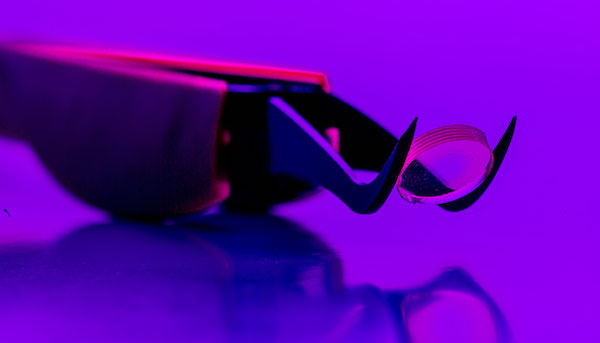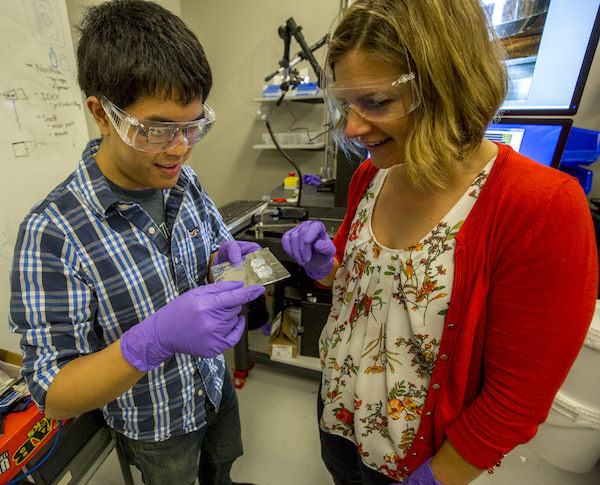
[Image above] A new 3-D printing technique, developed at Lawrence Livermore National Lab, could allow scientists to print glass that incorporates different refractive indices in a single flat optic, making finishing cheaper and easier. Credit: Jason Laurea; LLNL
Lately, 3-D printing of glass and optical glass has been getting a bit more ink, so to speak.
Nearly three years ago, MIT researchers shattered a glass barrier (pun intended) when they extruded molten glass through the nozzle of a 3-D printer.
Late last year, Luxexcel’s ophthalmic specialty lenses made 3Dprint.com’s top 10 list of 3-D printed things.
And just earlier this week, we reported on development of an optical lens 3-D printed from a resin in less than four hours.
Plus, nearly a year ago, an advancement in additive manufacturing of glass brought silica inks to the forefront as a solution to the high-temperature challenges that molten glass presents as a raw material.
And now, building on their previous research, scientists and engineers from Lawrence Livermore National Laboratory are experiencing success with silica and silica-titania inks in the 3-D printing of optical glass. Led by LLNL chemical engineer and research scientist Rebecca Dylla-Spears, the team was able to print small sample glass pieces that are comparable to commercial quality glass products.
Their method improves upon previous research to print molten glass extruded through a 3-D printer. One area of concern with extruding molten glass is that the process requires high temperatures—greater than 1,000o C (1,832oF). And the higher the temperature, the greater the manufacturing cost.
The other problem is that it’s challenging to get a smooth surface from molten glass prior to polishing.
“Components printed from molten glass often show texture from the 3-D-printing process,” Dylla-Spears explains in an LLNL article, “and even if you were to polish the surface, you would still see evidence of the printing process within the bulk material.”
To solve that challenge, the research team developed custom inks made of silica and silica-titania using a sol-gel process, according to the paper’s abstract. They combined this with direct ink writing, a technology they experimented with and we reported on last year. After the resulting printed pieces dried, the researchers sintered them to remove organic material.

LLNL chemical engineer and project lead Rebecca Della-Spears (right) and LLNL materials engineer Du Nguyen. Credit: LLNL
The inks enable the researchers to adjust optical, thermal, and mechanical properties, Dylla-Spears says in the article. “This approach allows us to obtain the index homogeneity that is needed for optics,” she adds. “Now we can take these components and do something interesting.”
Dylla-Spears says their current research advances the technology in two important ways.
“First, it demonstrates that 3-D-printed glasses can achieve optical quality refractive index homogeneity, which is a critical step toward making glass optics by 3-D printing,” she explains in an email. “Second, it shows that we can print glass compositions besides fumed silica using a tunable ink preparation method. In this case, we demonstrated both silica and silica-titania glasses.”
Although the team’s optical glasses were proof-of-concept-size samples, Dylla-Spears says they could use the method to make optical lenses with different structures that cannot be manufactured elsewhere. For instance, she suggests that “gradient refractive index lenses could be polished flat, replacing more expensive polishing techniques used for traditional curved lenses.”
The team has already applied for a patent and is currently in discussions with potential glass manufacturers.
“This technology could be used to make transmissive glass optics like optical lenses, freeform optics, correctors, and windows,” she writes. “It could also be used to create stable substrates for reflective optics. In addition, it could be used in a variety of non-optical applications where glasses would be considered.”
The paper, published in Advanced Materials Technologies, is “3D printed optical quality silica and silica–titania glasses from sol–gel feedstocks” (DOI: 10.1002/admt.201700323).
Want to read more articles like this? Subscribe to the Ceramic Tech Today newsletter to continue to receive the latest news in the ceramic and glass industry right in your inbox! Visit this link to get started.
